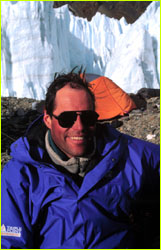
|
 |
 |
Eric Simonson Eric Simonson, who hales from Ashford, Washington, boasts a climbing career that spans nearly 30 years, including 20 years in the Himalayas. He climbed Everest in 1991, on his third attempt. Three times since then, he has stood within 100 meters of the summit. As expedition leader, Simonson is responsible for expedition logistics and organization for the climbing team. NOVA: What is the purpose of this expedition? SIMONSON: Our mission is twofold. On the one hand, we want to evaluate whether it was technically feasible for the 1924 expedition to have summited. Obviously we are aware of the significant climbing challenge afforded by the Second Step and we want to try to pin a more quantitative evaluation upon that climbing to see just how hard it really was. Virtually every climber that has climbed the Second Step since 1975 has done so utilizing the Chinese ladder. If we can climb the Second Step without the ladder I think we'll have a better idea of whether Mallory could have done it. Secondly we want to do a search in the area of the high camp looking for relics and artifacts from the 1924 expedition, and that would include obviously the camera. NOVA: Do you think that Mallory and Irvine could have climbed the Second Step? SIMONSON: When I climbed the Second Step in 1991 I used the Chinese ladder and I thought the terrain was quite difficult and challenging. It is difficult for me to think that they did it in 1924. Again, we know that Mallory was an excellent climber, and we know that the weather was quite good that day, so I'd be the first one to look forward to being corrected. But presently I'm dubious as to whether they would've been able to do it. We know from accounts of past expeditions that there is evidence of early Everest climbers in the vicinity of the high camp. The fact is that no one has really taken the time to look closely in those areas so our goal is to do just that: spend several days at extreme altitude examining as best we can the area around 27,000 feet to the west of the high camp. We think there may be a body in that area, and we know from the Chinese accounts that that body was dressed in old English attire, and we know that the climbers in 1924 were carrying cameras with them, so we will be looking for the cameras. NOVA: What happened to Mallory and Irvine? SIMONSON: I think it is very plausible that at some time they split up, and that Mallory pushed on. It was his third try on the mountain. I know when I went to the summit on my third try I was utterly determined and I felt the same way. I think it's utterly plausible that he perished high on the mountain. Whether he climbed the Second Step, again, I have doubts. My guess is that Irvine might have given Mallory his own oxygen and perhaps he tried to go down on his own without oxygen, and fell or got lost on the way down and the body that we think we may find at 27,000 feet may be that of Irvine. I see the interest in Mallory and Irvine from two different sides. On the one hand the public is interested in the obvious: Who was the first to climb Mount Everest? For me I find that less compelling a reason for my interest. From the standpoint of a mountaineer I think it is a lot more interesting to consider what they were doing 75 years ago with utterly primitive equipment—leather boots, canvas tents, iron oxygen cylinders—and to see the evolution of mountaineering in that context. It has been suggested that had they been successful and returned from the summit in 1924 that mountaineering might have evolved entirely differently than it has over the last 75 years. We've seen mountaineering evolve through a series of large expeditions. Only in the last decade or two has there been a swing to a more smaller or self-sufficient style. Also, I don't think we can take anything away from the British in 1953, to Hillary and Tenzing and their remarkable expedition and their achievement of the summit of Everest. Back to The Search Lost on Everest | High Exposure | Climb | History & Culture | Earth, Wind, & Ice E-mail | Previous Expeditions | Resources | Site Map | Everest Home Editor's Picks | Previous Sites | Join Us/E-mail | TV/Web Schedule About NOVA | Teachers | Site Map | Shop | Jobs | Search | To print PBS Online | NOVA Online | WGBH © | Updated November 2000 |
 Eric Simonson
Eric Simonson